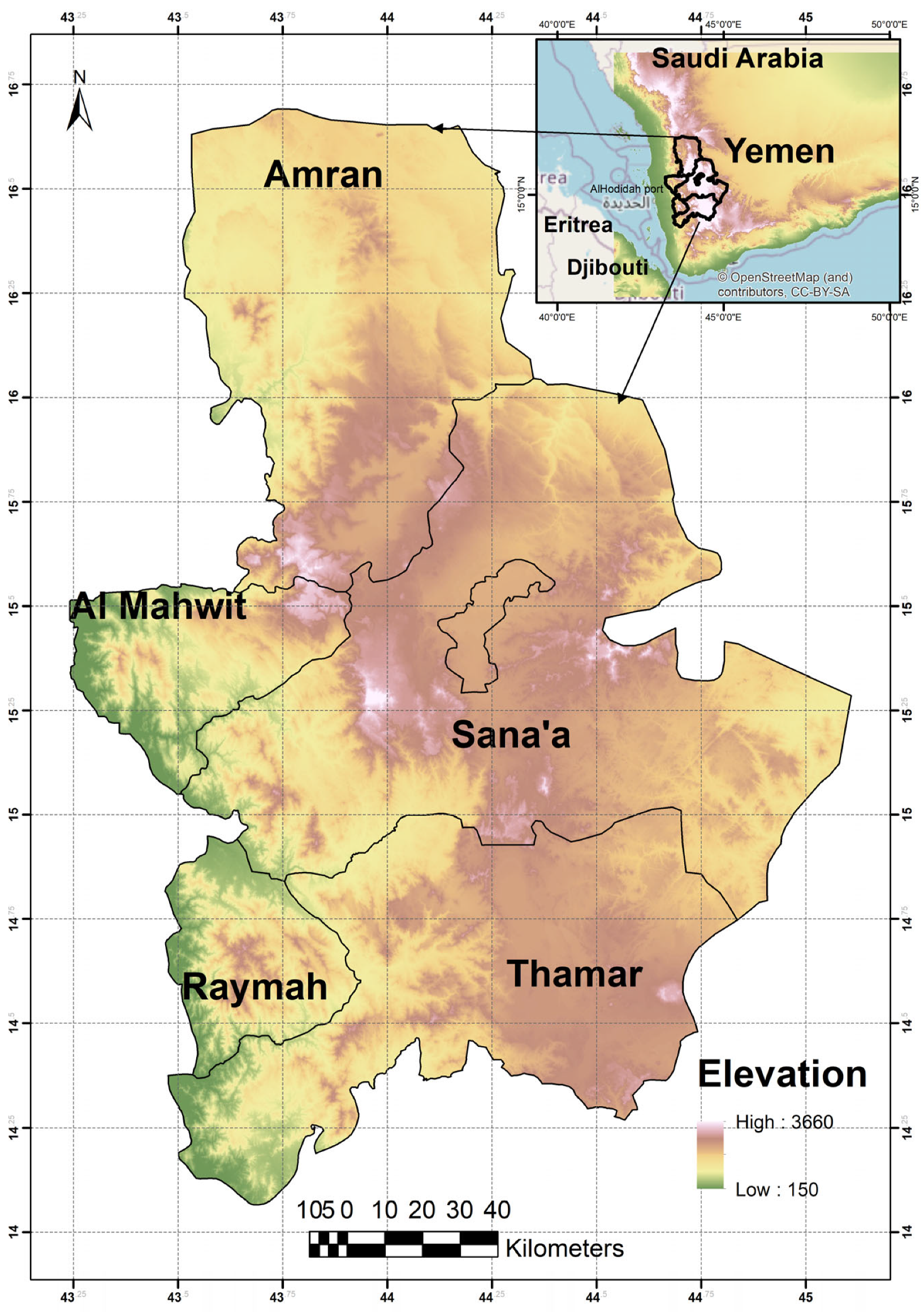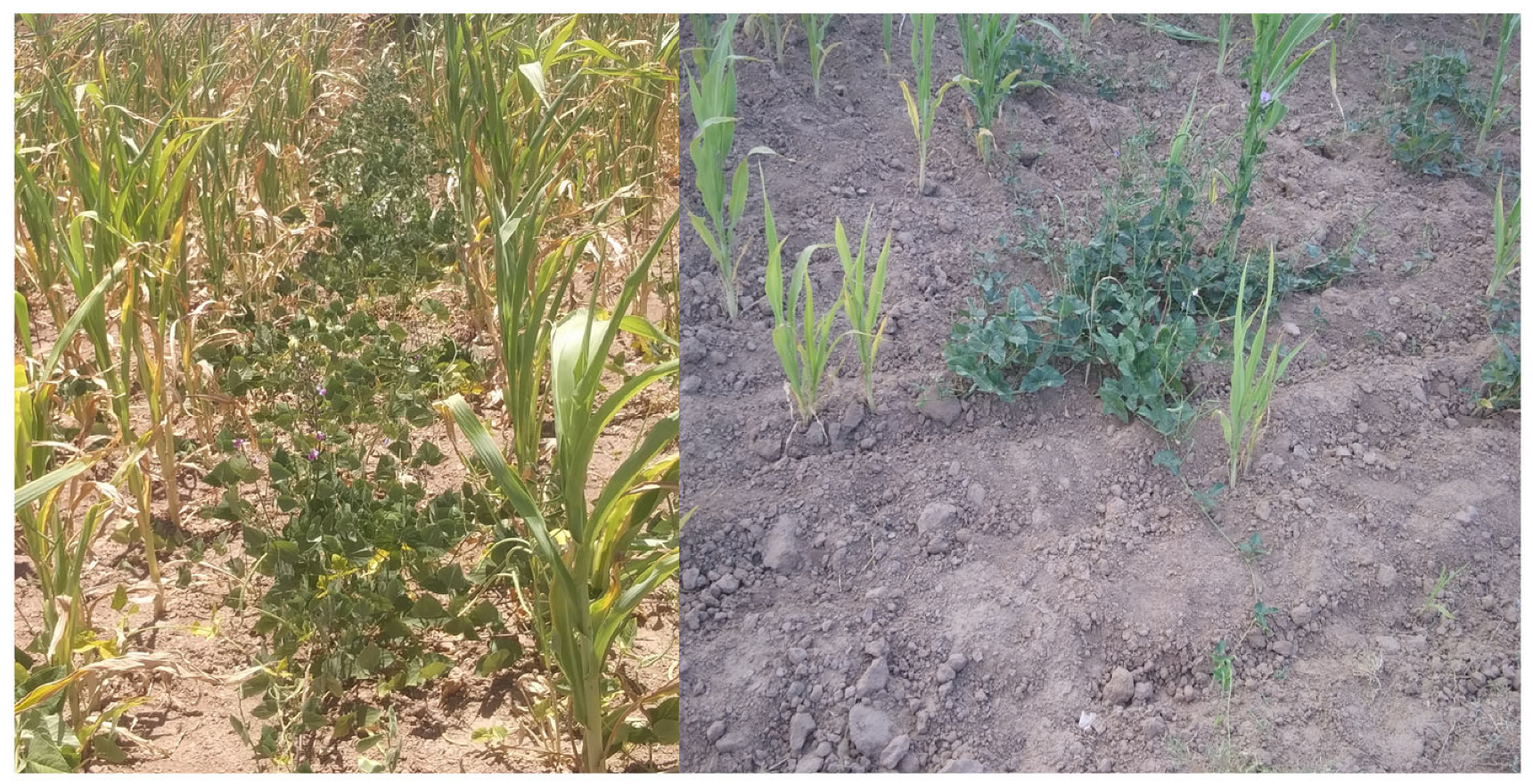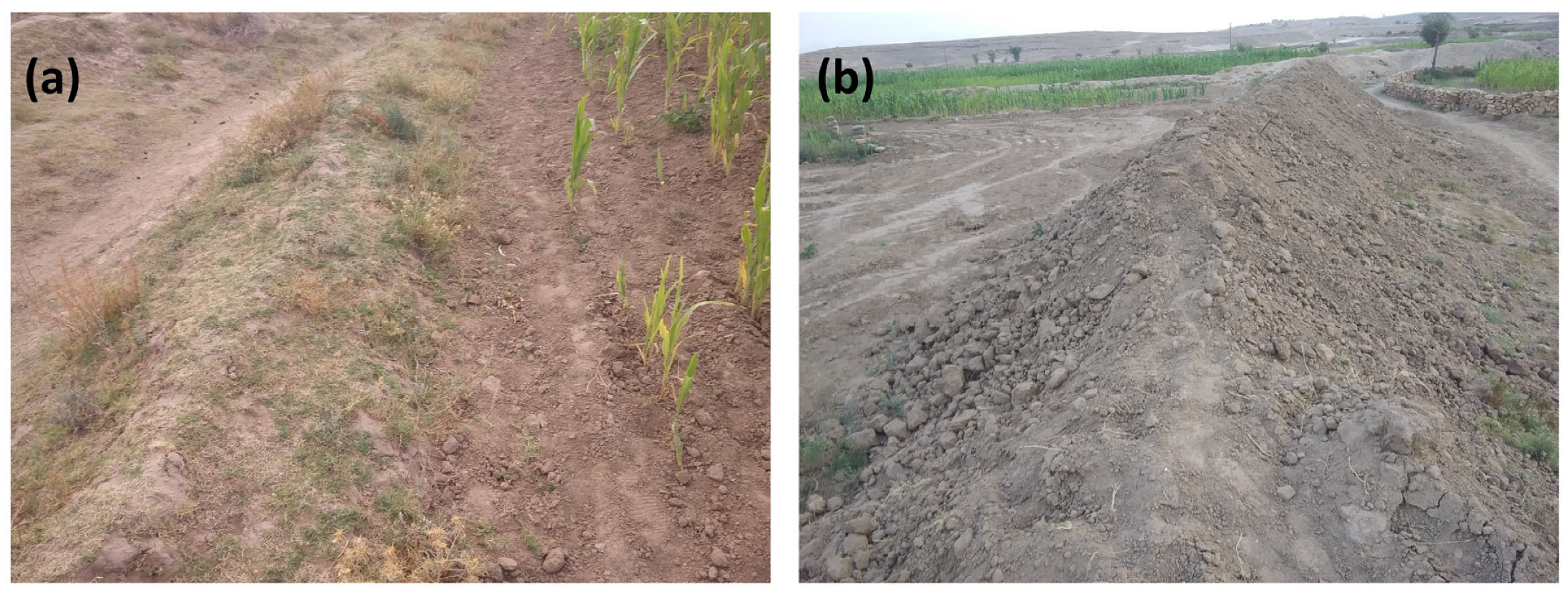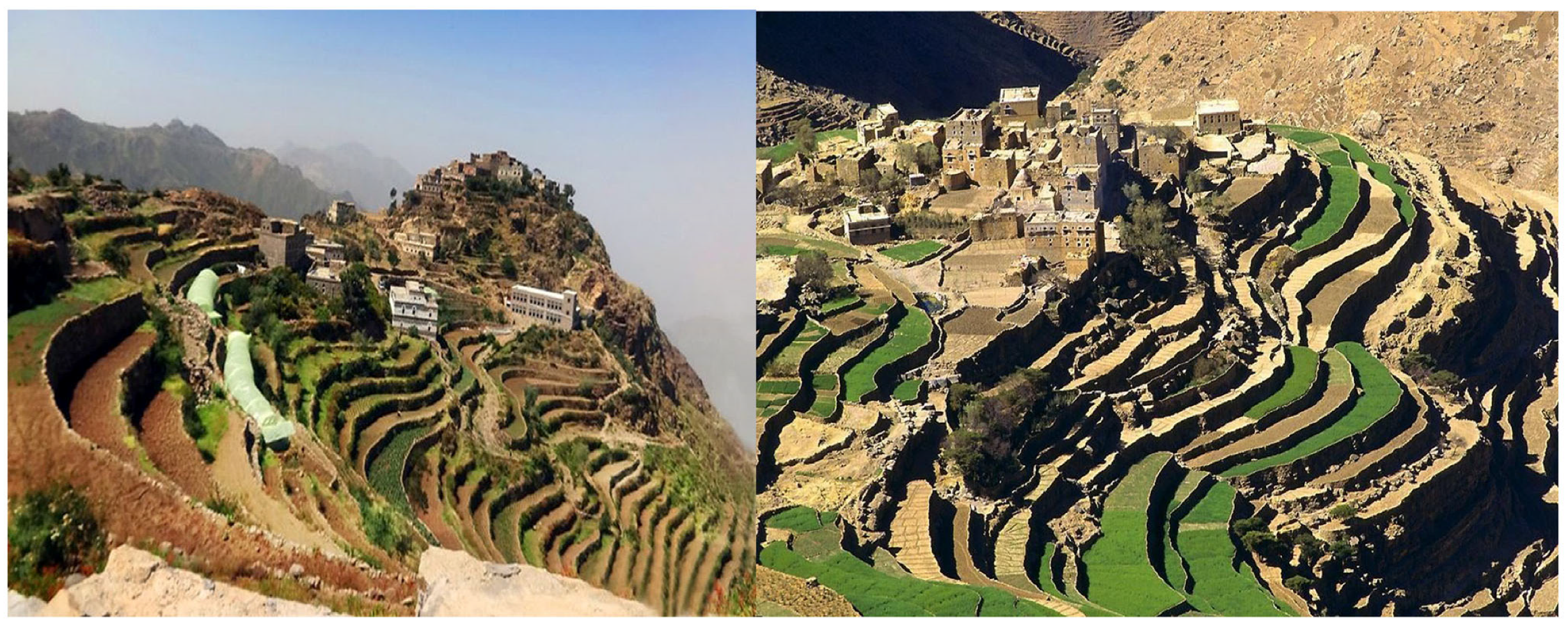Potential of Traditional Adaptation Measures in Mitigating the Impact of Climate Change
Abstract
1. Introduction
2. Material and Methods
2.1. The Study Area
2.2. Data Collection
3. Result and Discussion
3.1. Agricultural Water Management
3.1.1. Collection of Rainwater
3.1.2. Distribution of Rainwater (Outside and Inside Fields)
3.1.3. Introduction of Modern Irrigation Systems
3.1.4. Use of Groundwater in Irrigation
3.2. Farming Measures
3.2.1. Agroforestry
3.2.2. Inter-Cropping
3.2.3. Crops Rotation
3.2.4. Supporting Walls and Fields Boundaries
3.2.5. Control of Pests and Plant Diseases
3.3. Soil Protection Measures
3.3.1. Fertilizers and Improvement of Soil Fertility
3.3.2. Field Preparation and Soil Tillage
3.3.3. Control of Soil Compaction
3.4. Conservation of Natural Resources
3.4.1. Expanding the Agricultural Area
3.4.2. Protection of Runoff Catchment Area
3.4.3. Preserving Original Seeds
3.4.4. Conversion of the Agricultural Land into Residential Areas
3.4.5. Firewood Collection
3.5. Household Measures
3.5.1. Poultry and Livestock Breeding
3.5.2. Training Children on Water Consumption
3.5.3. Improving Water Quality in Traditional Ponds
3.5.4. Construction of Medium and Small Dams
3.5.5. Tillage Machinery Exchange
3.6. Social Aspects and Challenges
4. Conclusions
Author Contributions
Funding
Institutional Review Board Statement
Informed Consent Statement
Data Availability Statement
Acknowledgments
Conflicts of Interest
References
- Abbass, K.; Qasim, M.Z.; Song, H.; Murshed, M.; Mahmood, H.; Younis, I. A review of the global climate change impacts, adaptation, and sustainable mitigation measures. Environ. Sci. Pollut. Res. 2022, 29, 42539–42559. [Google Scholar] [CrossRef]
- Morrison, T.H.; Adger, W.N.; Brown, K.; Lemos, M.C.; Huitema, D.; Hughes, T.P. Mitigation and adaptation in polycentric systems: Sources of power in the pursuit of collective goals. WIREs Clim. Chang. 2017, 8, e479. [Google Scholar] [CrossRef]
- Hussain, M.; Butt, A.R.; Uzma, F.; Ahmed, R.; Irshad, S.; Rehman, A.; Yousaf, B. A comprehensive review of climate change impacts, adaptation, and mitigation on environmental and natural calamities in Pakistan. Environ. Monit. Assess. 2019, 192, 48. [Google Scholar] [CrossRef]
- Mensah, J. Sustainable development: Meaning, history, principles, pillars, and implications for human action: Literature review. Cogent Soc. Sci. 2019, 5, 1653531. [Google Scholar] [CrossRef]
- Eriksen, S.; Schipper, E.L.F.; Scoville-Simonds, M.; Vincent, K.; Adam, H.N.; Brooks, N.; Harding, B.; Khatri, D.; Lenaerts, L.; Liverman, D.; et al. Adaptation interventions and their effect on vulnerability in developing countries: Help, hindrance or irrelevance? World Dev. 2021, 141, 105383. [Google Scholar] [CrossRef]
- Musah-Surugu, J.I.; Anuga, S.W. Remittances as a Game Changer for Climate Change Adaptation Financing for the Most Vulnerable: Empirical Evidence from Northern Ghana. In Remittances as Social Practices and Agents of Change: The Future of Transnational Society; Meyer, S., Ströhle, C., Eds.; Springer International Publishing: Cham, Switzerland, 2023; pp. 343–367. [Google Scholar]
- Wesselink, A.; Challinor, A.J.; Watson, J.; Beven, K.; Allen, I.; Hanlon, H.; Lopez, A.; Lorenz, S.; Otto, F.; Morse, A.; et al. Equipped to deal with uncertainty in climate and impacts predictions: Lessons from internal peer review. Clim. Chang. 2015, 132, 1–14. [Google Scholar] [CrossRef]
- Brunner, L.; Lorenz, R.; Zumwald, M.; Knutti, R. Quantifying uncertainty in European climate projections using combined performance-independence weighting. Environ. Res. Lett. 2019, 14, 124010. [Google Scholar] [CrossRef]
- Rettie, F.M.; Gayler, S.; Weber, T.K.D.; Tesfaye, K.; Streck, T. High-resolution CMIP6 climate projections for Ethiopia using the gridded statistical downscaling method. Sci. Data 2023, 10, 442. [Google Scholar] [CrossRef]
- Noto, L.V.; Cipolla, G.; Pumo, D.; Francipane, A. Climate Change in the Mediterranean Basin (Part II): A Review of Challenges and Uncertainties in Climate Change Modeling and Impact Analyses. Water Resour. Manag. 2023, 37, 2307–2323. [Google Scholar] [CrossRef]
- Watts, R.G. Global Warming and the Future of the Earth; Springer Nature: Cham, Switzerland, 2022. [Google Scholar]
- Chokkavarapu, N.; Mandla, V.R. Comparative study of GCMs, RCMs, downscaling and hydrological models: A review toward future climate change impact estimation. SN Appl. Sci. 2019, 1, 1698. [Google Scholar] [CrossRef]
- Zhang, Q.; Li, Y.P.; Huang, G.H.; Wang, H.; Li, Y.F.; Liu, Y.R.; Shen, Z.Y. A novel statistical downscaling approach for analyzing daily precipitation and extremes under the impact of climate change: Application to an arid region. J. Hydrol. 2022, 615, 128730. [Google Scholar] [CrossRef]
- Doury, A.; Somot, S.; Gadat, S.; Ribes, A.; Corre, L. Regional climate model emulator based on deep learning: Concept and first evaluation of a novel hybrid downscaling approach. Clim. Dyn. 2023, 60, 1751–1779. [Google Scholar] [CrossRef]
- Mahon, R.; Greene, C.; Cox, S.-A.; Guido, Z.; Gerlak, A.K.; Petrie, J.-A.; Trotman, A.; Liverman, D.; Van Meerbeeck, C.J.; Scott, W.; et al. Fit for purpose? Transforming National Meteorological and Hydrological Services into National Climate Service Centers. Clim. Serv. 2019, 13, 14–23. [Google Scholar] [CrossRef]
- Gleixner, S.; Demissie, T.; Diro, G.T. Did ERA5 Improve Temperature and Precipitation Reanalysis over East Africa? Atmosphere 2020, 11, 996. [Google Scholar] [CrossRef]
- Zandler, H.; Senftl, T.; Vanselow, K.A. Reanalysis datasets outperform other gridded climate products in vegetation change analysis in peripheral conservation areas of Central Asia. Sci. Rep. 2020, 10, 22446. [Google Scholar] [CrossRef]
- Fan, X.; Jiang, L.; Gou, J. Statistical downscaling and projection of future temperatures across the Loess Plateau, China. Weather Clim. Extrem. 2021, 32, 100328. [Google Scholar] [CrossRef]
- Gebrechorkos, S.; Leyland, J.; Slater, L.; Wortmann, M.; Ashworth, P.J.; Bennett, G.L.; Boothroyd, R.; Cloke, H.; Delorme, P.; Griffith, H.; et al. A high-resolution daily global dataset of statistically downscaled CMIP6 models for climate impact analyses. Sci. Data 2023, 10, 611. [Google Scholar] [CrossRef]
- Perkins, B.M. Yemen: Between Revolution and Regression. Stud. Confl. Terror. 2017, 40, 300–317. [Google Scholar] [CrossRef]
- Abuseir, S. A systematic review of frequency and geographic distribution of water-borne parasites in the Middle East and North Africa. East. Mediterr. Health J. 2023, 29, 151–161. [Google Scholar] [CrossRef]
- Gadain, H.; Libanda, B. Agricultural Water Deficit Trends in Yemen. Atmosphere 2023, 14, 1263. [Google Scholar] [CrossRef]
- Varisco, D. Pumping Yemen Dry: A History of Yemen’s Water Crisis. Hum. Ecol. 2019, 47, 317–329. [Google Scholar] [CrossRef]
- Al-shalabi, M.; Billa, L.; Pradhan, B.; Mansor, S.; Al-Sharif, A.A.A. Modelling urban growth evolution and land-use changes using GIS based cellular automata and SLEUTH models: The case of Sana’a metropolitan city, Yemen. Environ. Earth Sci. 2013, 70, 425–437. [Google Scholar] [CrossRef]
- Dammag, A.Q.; Dai, J.; Cao, S.; Alabsi, A.A.; Derhem, B.Q.; Latif, H.Z. Sustainable Planning Strategies for Rural Land Use Using a Hybridized Technique and GIS: Application to An Nijād Village in Ibb City, Yemen. J. Urban Plan. Dev. 2023, 149, 05022052. [Google Scholar] [CrossRef]
- Haidera, M.; Alhakimi, S.A.; Noaman, A.; Kebsi, A.A.; Noaman, A.; Fencl, A.; Dougherty, B.; Swartz, C. Water scarcity and climate change adaptation for Yemen’s vulnerable communities. Local Environ. 2011, 16, 473–488. [Google Scholar] [CrossRef]
- Aljawzi, A.A.; Fang, H.; Abbas, A.A.; Khailah, E.Y. Assessment of Water Resources in Sana’a Region, Yemen Republic (Case Study). Water 2022, 14, 1039. [Google Scholar] [CrossRef]
- Alderwish, A.; Al-Eryani, M. An approach for assessing the vulnerability of the water resources of Yemen to climate change. Clim. Res. 1999, 12, 85–89. [Google Scholar] [CrossRef]
- Al-Jibly, A.A. The Climate Change Scenarios for Yemen for 2050. Governmental Report for Environmental Protection Authority Funded by UNDP; Department of Geography, Sana’a University: Sana’a, Yemen, 2008; p. 1437. [Google Scholar]
- EPA. Yemen’s Second National Communication under the United Nations Framework Convention on Climate Change. Governmental Report by the Environmental Protection Authority in Yemen with Full Fund by the Global Environmental Facility (GEF); EPA: Sana’a, Yemen, 2013; p. 2. [Google Scholar]
- AL-Falahi, A.H.; Saddique, N.; Spank, U.; Gebrechorkos, S.H.; Bernhofer, C. Evaluation the Performance of Several Gridded Precipitation Products over the Highland Region of Yemen for Water Resources Management. Remote Sens. 2020, 12, 2984. [Google Scholar] [CrossRef]
- Gandure, S.; Walker, S.; Botha, J.J. Farmers’ perceptions of adaptation to climate change and water stress in a South African rural community. Environ. Dev. 2013, 5, 39–53. [Google Scholar] [CrossRef]
- Makondo, C.C.; Thomas, D.S.G. Climate change adaptation: Linking indigenous knowledge with western science for effective adaptation. Environ. Sci. Policy 2018, 88, 83–91. [Google Scholar] [CrossRef]
- Reis, J.; Ballinger, R.C. Creating a climate for learning-experiences of educating existing and future decision-makers about climate change. Mar. Policy 2020, 111, 103–204. [Google Scholar] [CrossRef]
- Woldeamanuel, A.A.; Simane, B. Determinants of smallholder farmers’ decision to adopt adaptation options to climate change and variability in the Muger Sub basin of the Upper Blue Nile basin of Ethiopia. Agric. Food Secur. 2017, 6, 64. [Google Scholar] [CrossRef]
- Lennox, E. Double Exposure to Climate Change and Globalization in a Peruvian Highland Community. Soc. Nat. Resour. 2015, 28, 781–796. [Google Scholar] [CrossRef]
- Chen, J.; Yin, S.; Gebhardt, H.; Yang, X. Farmers’ livelihood adaptation to environmental change in an arid region: A case study of the Minqin Oasis, northwestern China. Ecol. Indic. 2018, 93, 411–423. [Google Scholar] [CrossRef]
- Aguilera, E.; Díaz-Gaona, C.; García-Laureano, R.; Reyes-Palomo, C.; Guzmán, G.I.; Ortolani, L.; Sánchez-Rodríguez, M.; Rodríguez-Estévez, V. Agroecology for adaptation to climate change and resource depletion in the Mediterranean region. A review. Agric. Syst. 2020, 181, 102809. [Google Scholar] [CrossRef]
- Rijal, S.; Gentle, P.; Khanal, U.; Wilson, C.; Rimal, B. A systematic review of Nepalese farmers’ climate change adaptation strategies. Clim. Policy 2022, 22, 132–146. [Google Scholar] [CrossRef]
- Baig, M.B.; Qureshi, A.M.; Straquadine, G.S.; Hajiyev, A. Realizing Food Security Through Sustainable Agriculture in the Republic of Yemen: Implications for Rural Extension. In Climate Change, Food Security and Natural Resource Management: Regional Case Studies from Three Continents; Behnassi, M., Pollmann, O., Gupta, H., Eds.; Springer International Publishing: Cham, Switzerland, 2019; pp. 19–60. [Google Scholar]
- Varisco, D. The State of Agriculture Kingdom of Yemen, 1918–1962: A Documentary Overview. AAS Work. Pap. Soc. Anthropol. 2018, 32, 1–72. [Google Scholar] [CrossRef][Green Version]
- Varisco, D. Agriculture in the Northern Highlands of Yemen: From Subsistence to Cash Cropping. J. Arab. Stud. 2018, 8, 171–192. [Google Scholar] [CrossRef]
- Al-Weshali, A.; Bamaga, O.; Borgia, C.; Steenbergen, F.; Al-Aulaqi, N.; Babaqi, A. Diesel Subsidies and Yemen Politics: Post-2011 Crises and their Impact on Groundwater Use and Agriculture. Water Altern. 2015, 8, 215–236. [Google Scholar]
- Hdeib, R.; Aouad, M. Rainwater harvesting systems: An urban flood risk mitigation measure in arid areas. Water Sci. Eng. 2023, 16, 219–225. [Google Scholar] [CrossRef]
- Vogel, H. Terrace farming in Yemen. J. Soil Water Conserv. 1987, 42, 18. [Google Scholar]
- Varisco, D. The future of terrace farming in Yemen: A development dilemma. Agric. Hum. Values 1991, 8, 166–172. [Google Scholar] [CrossRef]
- Hovden, E. Rainwater Harvesting Cisterns and Local Water Management. Master’s Thesis, University of Bergen, Bergen, Norway, 2006. [Google Scholar]
- Muharram, I.; Alsharjabi, K.; Mutahar, A. Traditional Rights of Irrigation Water in Some Yemeni Wadis. Int. J. Soc. Sci. Humanit. Res. 2019, 7, 538–545. [Google Scholar]
- Taher, T.; Bruns, B.; Bamaga, O.; Al-Weshali, A.; Steenbergen, F. Local groundwater governance in Yemen: Building on traditions and enabling communities to craft new rules. Hydrogeol. J. 2012, 20, 1177–1188. [Google Scholar] [CrossRef]
- Sheoran, S.; Kumar, S.; Kumar, P.; Meena, R.S.; Rakshit, S. Nitrogen fixation in maize: Breeding opportunities. Theor. Appl. Genet. 2021, 134, 1263–1280. [Google Scholar] [CrossRef] [PubMed]
- Tanwar, S.P.; Regar, P.L.; Datt, S.; Rathore, S.S. Sustainable Cropping System Intensification in Arid Region of India: Fallow Replacement with Limited Duration Sorghum–Legume Intercropping Followed by Eruca sativa Mill. Grown on Conserved Soil Moisture. Sustainability 2023, 15, 13006. [Google Scholar] [CrossRef]
- Biswas, T.; Kole, S.C. Soil Organic Matter and Microbial Role in Plant Productivity and Soil Fertility. In Advances in Soil Microbiology: Recent Trends and Future Prospects: Volume 2: Soil-Microbe-Plant Interaction; Adhya, T.K., Mishra, B.B., Annapurna, K., Verma, D.K., Kumar, U., Eds.; Springer: Singapore, 2017; pp. 219–238. [Google Scholar]
- Dhaliwal, S.S.; Sharma, S.; Sharma, V.; Shukla, A.K.; Walia, S.S.; Alhomrani, M.; Gaber, A.; Toor, A.S.; Verma, V.; Randhawa, M.K.; et al. Long-Term Integrated Nutrient Management in the Maize–Wheat Cropping System in Alluvial Soils of North-Western India: Influence on Soil Organic Carbon, Microbial Activity and Nutrient Status. Agronomy 2021, 11, 2258. [Google Scholar] [CrossRef]
- Aklan, M.; Al-Komaim, M.; de Fraiture, C. Site suitability analysis of indigenous rainwater harvesting systems in arid and data-poor environments: A case study of Sana’a Basin, Yemen. Environ. Dev. Sustain. 2023, 25, 8319–8342. [Google Scholar] [CrossRef]
- Iles, C.E.; Vautard, R.; Strachan, J.; Joussaume, S.; Eggen, B.R.; Hewitt, C.D. The benefits of increasing resolution in global and regional climate simulations for European climate extremes. Geosci. Model Dev. 2020, 13, 5583–5607. [Google Scholar] [CrossRef]
- Noaman, A. Indigenous knowledge for using and managing water harvesting techniques in Yemen. 2004. Available online: https://www.researchgate.net/publication/237613176_Indigenous_knowledge_for_using_and_managing_water_harvesting_techniques_in_Yemen (accessed on 1 October 2023).
- Pankievicz, V.C.S.; Irving, T.B.; Maia, L.G.S.; Ané, J.-M. Are we there yet? The long walk towards the development of efficient symbiotic associations between nitrogen-fixing bacteria and non-leguminous crops. BMC Biol. 2019, 17, 99. [Google Scholar] [CrossRef]
- Aklan, M.; de Fraiture, C.; Hayde, L.G.; Moharam, M. Why indigenous water systems are declining and how to revive them: A rough set analysis. J. Arid Environ. 2022, 202, 104765. [Google Scholar] [CrossRef]








| Activity | Location | Topography | Current status | Recommendation |
|---|---|---|---|---|
| Terraces | East and north districts of Al Mahwit, west of the Sana’a capital, and in the eastern districts of Raymah governorate | Complex, and steep topography | 30–35% of terraced lands are degraded | Maintenance, and rehabilitation of terraces is urgently needed. More storages above terraces can be built to reduce water velocity |
| Modern irrigation | North and east of Sana’a capital, in Amran, and northeastern districts of Thamar governorate | Flat to semi-flat area | Not widely applied, | Experiment fields are recommended, education programs to save groundwater use in irrigation is urgently needed |
| Rainwater harvesting | Common practice across the region | In complex and flat topography zones | Subject to deterioration | Maintenance is needed, expansion in building storages is highly recommended |
| Soil protection measures | Common practice | In complex and flat topography zones | Subject to neglect, dependency in manufactured fertilizers | Supporting of fields wall is regularly needed, manure and ash supply to field should continue |
| Tillage machine exchange | Common practice across the region | In flat and terraced fields | Widely practiced | New and modern machine (e.g., two-wheel tractor) is recommended |
| Original seed preservation | Common in all districts | In complex and flat topography zones | Degraded | Education programs, and new approaches along with the old practices are recommended |
| Soil fertilization | Common practice | In complex and flat topography zones of the region | Subject to deterioration | Livestock breeding, soil fermentation should continue as in the past |
| Inter-cropping | Common farming | Common in all rural areas | Subject to deterioration | Awareness program and saving of legumes original seed will assure practicing inter-cropping |
| Agroforestry | West of Sana’a capital, east of Al Mahwit and in the eastern districts of Thamar and Raymah governorate | In complex topography zone | Degraded | Awareness program in plantation is recommended |
| Groundwater management | Critical issue all over the region | Flat and complex topography area | Highly degraded | Prevention of illegal drilling, establishment of water use rights will improve the situation of groundwater management |
| Control of pests and plant diseases | Common farming practice | Flat and semi-flat areas | Subject to deterioration | Import of hazardous pesticides should be regulated, awareness program on the importance of old practice should be encouraged |
Disclaimer/Publisher’s Note: The statements, opinions and data contained in all publications are solely those of the individual author(s) and contributor(s) and not of MDPI and/or the editor(s). MDPI and/or the editor(s) disclaim responsibility for any injury to people or property resulting from any ideas, methods, instructions or products referred to in the content. |
© 2023 by the authors. Licensee MDPI, Basel, Switzerland. This article is an open access article distributed under the terms and conditions of the Creative Commons Attribution (CC BY) license (https://creativecommons.org/licenses/by/4.0/).
Share and Cite
AL-Falahi, A.H.; Barry, S.; Gebrechorkos, S.H.; Spank, U.; Bernhofer, C. Potential of Traditional Adaptation Measures in Mitigating the Impact of Climate Change. Sustainability 2023, 15, 15442. https://doi.org/10.3390/su152115442
AL-Falahi AH, Barry S, Gebrechorkos SH, Spank U, Bernhofer C. Potential of Traditional Adaptation Measures in Mitigating the Impact of Climate Change. Sustainability. 2023; 15(21):15442. https://doi.org/10.3390/su152115442
Chicago/Turabian StyleAL-Falahi, Ali H., Souleymane Barry, Solomon H. Gebrechorkos, Uwe Spank, and Christian Bernhofer. 2023. "Potential of Traditional Adaptation Measures in Mitigating the Impact of Climate Change" Sustainability 15, no. 21: 15442. https://doi.org/10.3390/su152115442
APA StyleAL-Falahi, A. H., Barry, S., Gebrechorkos, S. H., Spank, U., & Bernhofer, C. (2023). Potential of Traditional Adaptation Measures in Mitigating the Impact of Climate Change. Sustainability, 15(21), 15442. https://doi.org/10.3390/su152115442







